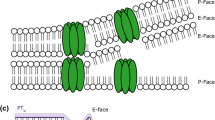Summary
The ultrastructure of the central layer and the contributing plasma membranes of tight junctions has been studied in epithelia of the jejunum and colon of mice.
Examination of freeze-etched plasma membranes of epithelial cells has revealed that they consist of a central layer, with fracturing characteristics similar to bimolecular lipid leaflets, which is covered on both sides with a layer of particles.
The “fusion” of the outer membrane surfaces of adjacent cells in the region of the tight junction leads to the formation of a new common structure consisting of a meshwork of fibrils embedded in a matrix substance. The fibrils probably contain protein. They have a diameter of 65 ± 10 Å and are linked together so that they form around the distal end of each cell a continuous belt-like meshwork which is extended proximally at the joints where three cells meet. As the fibrillar mesh appears to be strongly attached to the central lipid layer of the two adjoining membranes, in contrast to the weakly bound surrounding matrix, it is believed that the fibrils forming the continuous meshwork could be the mechanical coupling and the sealing elements of the tight junction. Their arrangement in the form of a concertinalike mesh would make the whole structure very flexible. In the region of the junction the membranes are constricted along the lines of attachment to the fibrils and bulge outwards,i.e. towards the cytoplasm, in the areas of the matrix material. In the resulting grooves on the cytoplasmic side of the plasma membranes regularly spaced particles with a diameter of 90 ± 10 Å can be detected. Various observations suggest that these particles could be connected through the central layer of the membranes to the fibrils on the other side. This would offer a possible explanation for the known abhesion properties of tight junctions. The described structures are also evaluated in terms of current theories of cell communication.
Similar content being viewed by others
References
Benson, A. A., 1966: On the orientation of lipids in chloroplast and cell membranes. J. Amer. Oil Chem. Soc.43, 265–270.
Branton, D., 1966: Fracture faces of frozen membranes. Proc. nat. Acad. Sci. U.S.A.55, 1048–1056.
—, 1967: Fracture faces of frozen myelin. Exp. Cell Res.45, 703–707.
—, andH. Moor, 1964: Fine structure in freeze-etchedAllium cepa L. root tips. J. Ultrastruct. Res.11, 401–411.
—, andR. Park, 1967: Subunits in chloroplast lamellae. J. Ultrastruct. Res.19, 283–303.
Bullivant, S., andW. R. Loewenstein, 1968: Structure of coupled and uncoupled cell junctions. J. Cell Biol.37, 621–632.
Danielli, J. F., andH. Davson, 1935: A contribution to the theory of permeability of thin films. J. cell. comp. Physiol.5, 495–508.
— —, 1952: The structure of the plasma membrane, in: The permeability of natural membranes. (H. Davson andJ. F. Danielli, Eds.), 57–71. London and New York: Cambridge University Press.
Deamer, D. W., andD. Branton, 1967: Fracture planes in an icebilayer model membrane system. Science158, 655–657.
Dewey, M. M., andL. Barr, 1964: A study of the structure and the distribution of the nexus. J. Cell Biol.23, 553–585.
Farquhar, M. G., andG. E. Palade, 1963: Junctional complexes in various epithelia. J. Cell Biol.17, 375–412.
— —, 1965: Cell junction in amphibian skin. J. Cell Biol.26, 263–291.
Fawcett, D. W., 1958: Structural specializations of the cell surface, in: Frontiers in Cytology. (S. L. Palay, Ed.), 19. New Haven: Yale University Press.
Grant, R. A., R. W. Cox, andR. W. Horne, 1967: The structure and assembly of collagen fibrils. II. An electron microscope study of cross-linked collagen. J. roy. micr. Soc.87, 143–155.
Green, D. E., andJ. F. Perdue, 1966: Membranes as expressions of repeating units. Proc. nat. Acad. Soc. U.S.A.55, 1295–1302.
Jost, M., 1965: Die Ultrastruktur vonOscillatoria rubescens D. C., Arch. Mikrobiol.50, 211–245.
Kaye, G. I., andG. D. Pappas, 1962: Studies on the cornea. I. The fine structure of the rabbit cornea and the uptake and transport of colloidal particles by the corneain vivo. J. Cell Biol.12, 457–479.
Loewenstein, W. R., 1966: Permeability of membrane junctions, Conf. on Biol. Membranes: Recent Progress. Ann. N.Y. Acad. Sci.137, 441–472.
— 1967: On the genesis of cellular communication. Develop. Biol.15, 503–520.
Macrobbie, E. A. C., andH. H. Ussing, 1961: Osmotic behaviour of the epithelial cells of frog skin. Acta Physiol. Scand.53, 348.
Moor, H., andK. Mühlethaler, 1963: The fine structure in frozen-etched yeast cells. J. Cell Biol.17, 609–628.
—,C. Ruska undH. Ruska, 1964: Elektronenmikroskopische Darstellung tierischer Zellen mit der Gefrierätzungstechnik. Z. Zellforsch.62, 581–601.
Mueller, P., andD. O. Rudin, 1968: Resting and action potentials in experimental bimolecular lipid membranes. J. theor. Biol.18, 222–258.
Mühlethaler, K., H. Moor, andJ. W. Szarkowski, 1965: The ultrastructure of the chloroplast lamellae. Planta67, 305–323.
Rayns, D. G., F. O. Simpson, andW. S. Bertaud, 1968: Surface features of striated muscle cells. I. Guinea pig cardiac muscle. J. Cell Sci.3, 467–474.
Remsen, C. C., 1966: The fine structure of frozen-etchedBacillus cereus spores. Arch. Mikrobiol.54, 266–275.
Robertson, J. D., 1959: The ultrastructure of cell membranes and their deviates, in: Biochem. Soc. Symp.16. The structure and function of subcellular components. 3–43. London and New York: Cambridge University Press.
Sabatini, D. S., K. Bensch, andR. J. Barrnett, 1963: Cytochemistry and electron microscopy. The preservation of cellular ultrastructure and enzymatic activity by aldehyde fixation. J. Cell Biol.17, 19–58.
Staehelin, A., 1966: Die Ultrastruktur der Zellwand und des Chloroplasten vonChlorella. Z. Zellforsch.74, 325–350.
— 1968: The interpretation of freeze-etched artificial and biological membranes. J. Ultrastruct. Res.22, 326–347.
— 1968: Ultrastructural changes in the plasmalemma and the cell wall during the life cycle ofCyanidium caldarium. Proc. Roy. Soc. B.171, 249–259.
Steere, R. L., 1957: Electron microscopy of structural detail in frozen biological specimes. J. Biophys. Biochem. Cytol.3, 45–60.
Author information
Authors and Affiliations
Rights and permissions
About this article
Cite this article
Staehelin, L.A., Mukherjee, T.M. & Williams, A.W. Freeze-etch appearance of the tight junctions in the epithelium of small and large intestine of mice. Protoplasma 67, 165–184 (1969). https://doi.org/10.1007/BF01248737
Received:
Issue Date:
DOI: https://doi.org/10.1007/BF01248737




